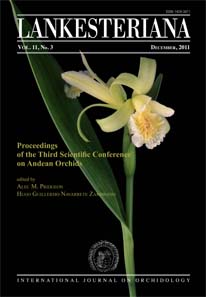Active mountain building and the distribution of "core" Maxillariinae species in tropical Mexico and Central America
DOI:
https://doi.org/10.15517/lank.v11i3.18283Keywords:
Central America, geology, geography, Orchidaceae, Maxillariinae, distributionAbstract
The observation that southeastern Central America is a hotspot for orchid diversity has long been known and confirmed by recent systematic studies and checklists. An analysis of the geographic and elevation distribution demonstrates that the most widespread species of “core” Maxillariinae are all adapted to life near sea level, whereas the most narrowly endemic species are largely distributed in wet highland environments. Drier, hotter lowland gaps exist between these cordilleras and evidently restrict the dispersal of the species adapted to wetter, cooler conditions. Among the recent generic realignments of “core” Maxillariinae based on molecular phylogenetics, the Camaridium clade is easily the most prominent genus in Central America and is largely restricted to the highlands of Costa Rica and Panama, indicating that this region is the ancestral home of this genus and that its dispersal limits are drier, lowland cordilleran gaps. The mountains of Costa Rica and Panama are among the geologically youngest topographic features in the Neotropics, reflecting the complex and dynamic interactions of numerous tectonic plates. From consideration of the available geological evidence, I conclude that the rapid growth of the mountain ranges in Costa Rica and Panama during the late Cenozoic times created, in turn, very rapid ranges in ecological life zones and geographic isolation in that part of the isthmus. Thus, I suggest that these recent geologic events were the primary drivers for accelerated orchid evolution in southeastern Central America.
Downloads
Downloads
Published
How to Cite
Issue
Section
License
According to the Open Access policy promoted by the University of Costa Rica, all the papers published by Lankesteriana are licensed under the Creative Commons copyright and can be downloaded free of charge. The journal holds copyright and publishing rights under the CC BY-NC-ND 3.0 CR license.
Before the publication of the materials submitted by the author(s) in LANKESTERIANA, the author(s) hereby assign all rights in the article to the Lankester Botanical Garden.





